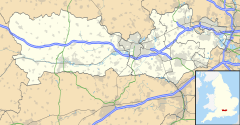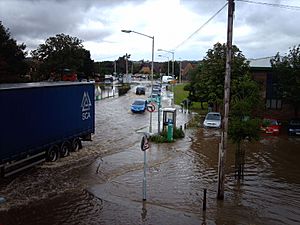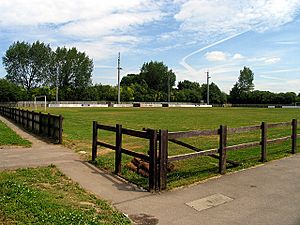Thatcham facts for kids
Quick facts for kids Thatcham |
|
|---|---|
| Market town and civil parish | |
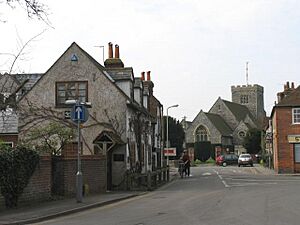 Thatcham town centre |
|
| Area | 21.76 km2 (8.40 sq mi) |
| Population | 25,464 (2021 Census) |
| • Density | 1,170/km2 (3,000/sq mi) |
| OS grid reference | SU5167 |
| Civil parish |
|
| Unitary authority |
|
| Ceremonial county | |
| Region | |
| Country | England |
| Sovereign state | United Kingdom |
| Post town | THATCHAM |
| Postcode district | RG18, RG19 |
| Dialling code | 01635 |
| Police | Thames Valley |
| Fire | Royal Berkshire |
| Ambulance | South Central |
| EU Parliament | South East England |
| UK Parliament |
|
Thatcham is a historic market town in West Berkshire, England. It sits in the valley of the River Kennet. The town is about 3 km east of Newbury and 14 km west of Reading. London is about 54 km to the east.
Thatcham has a very long history. Some people say it's the oldest place in Great Britain where people have lived continuously. In 2021, about 25,464 people lived there. Thatcham is also part of a larger area with Newbury, which has over 70,000 residents. The town is located on the A4 Bath Road, an old main road between London and Bristol.
Contents
What is Thatcham Like?
Thatcham is located along the River Kennet and the Kennet and Avon Canal. The A4 road also runs through it. The area includes the town of Thatcham itself, plus nearby places like Henwick, Dunston Park, Colthrop, and the village of Crookham. This also covers parts of Crookham Common and the old RAF Greenham Common airfield.
Long ago, the Thatcham area was much bigger. It included places like Midgham, Cold Ash, Ashmore Green, and Greenham. Just south of the town, you can find the Thatcham Reed Beds. This area is a special place for nature, known as a Site of Special Scientific Interest (SSSI). This means it's protected because of its important plants, animals, or geology.
Where Did the Name Thatcham Come From?
The name Thatcham might have come from an old Saxon chief named Tace. He may have started a village around 500 AD. This settlement might have been called Taceham, where ham meant village in Saxon.
However, some of the oldest records from around 951 and 975 show the name as Thaecham. The word Thaec comes from the Saxon word for "roof-covering." The ham part might have been a shorter version of hamm, meaning a river meadow. So, the name could mean "roof-covered meadow by the river."
A Look at Thatcham's Past
The area around Thatcham has signs of people living there since prehistoric times. It was even listed in the Guinness Book of Records as possibly the oldest continuously inhabited place in Britain. Scientists have found well-preserved remains of a mesolithic (Middle Stone Age) settlement nearby. This settlement dates back to between 8400 and 7700 BCE. There is also proof of people living here during the Bronze Age and Iron Age. Even the Romans were active in this area.
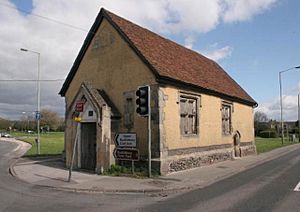
In 1086, after the Norman Conquest, the town's name was written as Taceham in the Domesday Book. The name changed a few times until it became Thatcham in the 1500s. The town became very successful around 1304. This was when the Chapel of St. Thomas the Martyr was allowed to hold church services. This chapel is now called the Old Bluecoat School. At that time, Thatcham had more people living there than Newbury! The chapel is a very important historic building.
There is also a Norman parish church called St. Mary's. Most of it was rebuilt in 1857. People believe it stands on the same spot as an even older Anglo-Saxon church. It used to be known as St. Luke's. This church is also a very important historic building.
In 1121, King Henry I started Reading Abbey. He gave it many lands, including the Manor of Thatcham. Because of this, Thatcham's old local government area (called a Hundred) stopped existing. In 1141, the Empress Matilda gave Thatcham church to Reading Abbey.
During World War II, Thatcham had one of the largest Prisoner of War camps in the south of England. It was known as Camp 1001. Thatcham's population grew a lot in the second half of the 1900s. It went from 5,000 people in 1951 to over 22,000 in 2001.
When Thatcham Flooded
On July 20, 2007, parts of Thatcham experienced severe flooding. This happened because of very heavy rain. Three times the usual amount of rain for July fell in just 24 hours! The rivers didn't overflow, but a huge amount of water flowed down the hills from Cold Ash and Bucklebury. Many roads became impossible to use. Hundreds of students at Kennet School were stuck and tried to cross Stoney Lane using ropes. About 1,100 homes were affected, and many people had to move into temporary homes.
Important Places in Thatcham
Schools in Thatcham
Thatcham has many primary schools for younger children. The only secondary school in Thatcham for older students is Kennet School.
Motor Insurers' Research Centre
The Motor Insurers' Automotive Research Centre is located in Colthrop. This centre creates the "Thatcham categories." These are the official rules for vehicle immobilisers and alarms that the car insurance industry uses.
International Seismological Centre
The International Seismological Centre is also in Thatcham. This organization collects, studies, and publishes information about earthquakes from all over the world. It's located on Pipers Lane.
Getting Around Thatcham
The Thatcham railway station is on the Reading to Taunton line. You can catch regular trains between Reading and Newbury. There are also services between Paddington (in London) and Bedwyn. These trains are run by Great Western Railway.
The main east-west road through Thatcham is the A4 Bath Road. This road connects London and Bristol. However, for long journeys, most people now use the M4 motorway. The M4 runs almost parallel to the A4, about 3 km north of Thatcham. The closest motorway exit is Junction 13 at Chieveley.
Sports and Fun in Thatcham
Thatcham has its own football team, Thatcham Town. They play their games at Waterside Park, which is about 300 metres south of the Thatcham railway station. In the 2017–18 season, the club made history by reaching the final of the FA Vase. They were the first team from Berkshire to reach a national cup final!
The Thatcham Town Cricket Club plays at a ground on Brownsfield Road. The Henwick Worthy Sports Ground is home to the Newbury and Thatcham Hockey Club and the Thatcham Rugby Union Football Club. Many other amateur and youth sports also take place there.
How Thatcham is Governed
Thatcham is divided into four areas, called wards, for local elections. These are Thatcham Central, Thatcham North, Thatcham South & Crookham, and Thatcham West. Seven councillors represent Thatcham on the West Berkshire Council. Currently, five are from the Liberal Democrats and two are from the Conservatives.
These same wards are used for town council elections. The town council has fourteen Liberal Democrats, three Conservatives, and one Green Party member. At the national level, Thatcham is part of the Newbury area. Since 2024, its MP is Lee Dillon from the Liberal Democrats.
Twin Town
Thatcham is twinned with Nideggen, a town in North Rhine-Westphalia, Germany. This means the two towns have a special friendship and often exchange visits.
Who Lives in Thatcham?
Most people in Thatcham work in light industry, sales, distribution, shops, and public services.
| Output area | Homes owned outright | Owned with a loan | Socially rented | Privately rented | Other | km2 roads | km2 water | km2 domestic gardens | Usual residents | km2 |
|---|---|---|---|---|---|---|---|---|---|---|
| Civil parish | 2,640 | 4,629 | 1,439 | 1,160 | 65 | 0.871 | 0.676 | 2.323 | 25,267 | 21.78 |
See also
 In Spanish: Thatcham para niños
In Spanish: Thatcham para niños


